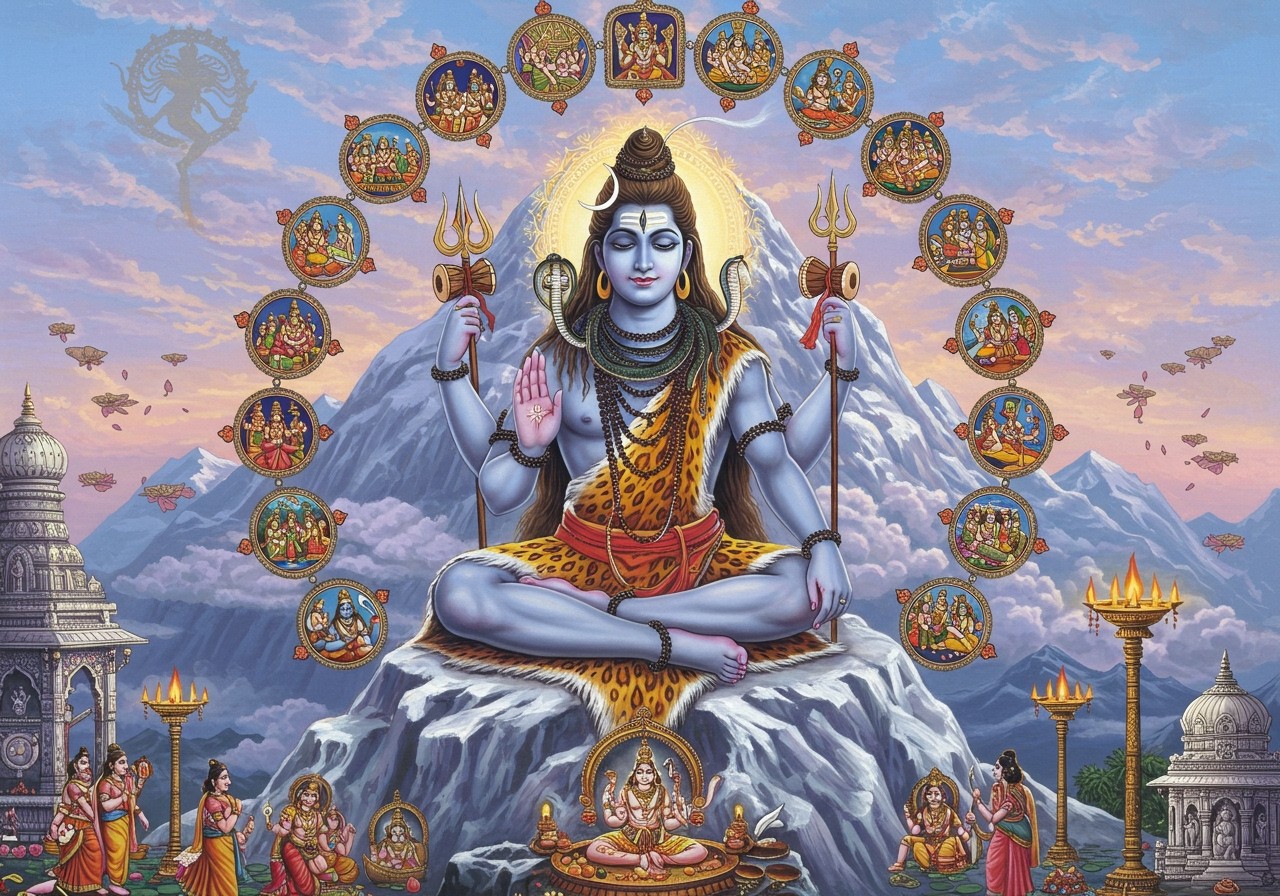
The Thiruvilaiyadal Puranam, a beloved text in Tamil literature, narrates the divine leelas (plays) of Lord Shiva in Madurai. It beautifully captures the cultural and spiritual heart of Tamil Nadu, weaving together captivating stories of devotion, miracles, and divine intervention. To truly appreciate its depth and significance, understanding its structure is key. This guide offers a simple overview of the Puranam’s core components: Kandam, Padalam, and Padas, helping you navigate this timeless narrative with ease.
Understanding the Kandam
Think of a ‘Kandam’ as a major chapter in the Thiruvilaiyadal Puranam. Each Kandam explores a distinct theme or set of divine plays by Lord Shiva. This thematic division is reflective of its origins in the oral tradition, making the epic easier to recount and remember. For instance, some Kandams center around Shiva’s interactions with his devotees, illuminating themes of unwavering faith and divine grace. This structured approach to storytelling has played a vital role in preserving the Puranam across generations, maintaining its cultural and religious importance among Tamil speakers.
Exploring the Padalam
Within each Kandam, the story unfolds further through ‘Padalams’. Imagine these as individual episodes within a larger narrative arc, each Padalam contributing a unique facet to the overall tapestry. These Padalams delve into the specifics of Shiva’s divine acts, painting vivid pictures of his interactions with humanity, often revealing profound lessons in dharma and devotion. One such example is the celebrated story of Nakkeerar, where the poet engages in a literary debate with Shiva himself, highlighting the interplay between human intellect and divine wisdom. This careful arrangement ensures a smooth transition between stories, weaving a coherent narrative throughout the Puranam.
Padalams serve a dual purpose – catering to both scholarly analysis and devotional reading. While scholars may explore the deeper allegorical meanings, devotees find solace and inspiration in the simple beauty of the stories. This balance makes the text accessible to all, enriching both academic and spiritual pursuits.
Beyond the realm of literature, Padalams serve as an inspiration for various art forms. Their rhythmic beauty and evocative storytelling find expression in traditional Tamil music, dance, and theatrical performances, showcasing the rich cultural tapestry woven by these sacred narratives.
The Essence of Padas (Songs)
The Thiruvilaiyadal Puranam is brought to life through its ‘Padas’, or devotional songs. These hymns, set to traditional melodies, infuse the narratives with an emotional depth and cultural richness. These soul-stirring compositions enrich the storytelling and connect us to the divine on a deeper level. Set to music, these Padas play an essential role in preserving the Puranam’s oral tradition. The melodic structure facilitates memorization, enabling the seamless transmission of these stories across generations. A prime example is the Pada recounting Shiva’s assistance to Dharumi, appearing as a poet to help him win a competition – a tale that entertains while imparting wisdom. These Padas often find their place in religious ceremonies and festivals throughout Tamil Nadu, fostering a sense of community and shared devotion.
Beyond their communal significance, Padas also offer a pathway for personal devotion. Individuals find solace in the verses, forging a deep connection with the divine stories. In this way, Padas bridge the gap between individual spirituality and collective worship, serving as a powerful medium for both.
Delving Deeper into the Thiruvilaiyadal Puranam
The Thiruvilaiyadal Puranam isn’t just a collection of stories; it’s a window into the divine, offering glimpses into the nature of devotion, righteousness, and the interplay between the human and the divine. Here are some key aspects to explore:
- Divine Sports (Thiruvilaiyadals): These “sacred games” of Shiva showcase his interventions in the human world, often to test devotion, impart wisdom, or deliver justice. They highlight the unpredictable and often playful nature of the divine, reminding us that even the most profound lessons can come in unexpected ways.
- Legends of Madurai: The city of Madurai serves as the backdrop for many of these stories, highlighting its spiritual significance and the divine presence of Shiva and his consort Meenakshi (an incarnation of Parvati). These tales are deeply interwoven with the city’s history and identity, strengthening its cultural and religious importance.
- Paranjothi Munivar: This 16th-century poet compiled the Thiruvilaiyadal Puranam, gathering these ancient legends into a cohesive narrative. His contribution ensured the preservation and transmission of these stories for generations to come, enriching Tamil literature and spiritual tradition.
- Key Themes: Devotion, divine intervention, justice, and the importance of Tamil culture are recurring themes throughout the Puranam. They offer timeless wisdom on navigating life’s challenges and understanding the complex relationship between humanity and the divine.
- Narrative Structure: The sage Agastya narrates the 64 divine sports to his disciples in Kasi, having learned them from Murugan, who in turn heard them from Shiva as he recounted them to Parvati (Uma). This layered storytelling emphasizes the oral tradition and the reverence for lineage within Hindu spiritual practices.
Some of the most well-known stories include:
- Shiva appearing as a poet to guide Dharumi to victory in a literary contest, showcasing the divine support available to those who are dedicated to their craft.
- The tale of Nakkeerar, a poet who boldly challenges Shiva on the nuances of a poem, emphasizing the importance of questioning and intellectual discourse even in the face of the divine.
- The divine union of Shiva and Parvati, with Parvati born as a fisherwoman, highlighting the transcendence of social barriers in matters of love and devotion.
- Shiva embracing the form of a Siddhar (enlightened being) and performing miracles in Madurai, underscoring his compassion and direct engagement with the human world.
Learn about Lord Varahaswamy’s significance in Hindu mythology. You might also enjoy exploring the divine trinity of Varaha, Lakshmi, and Narasimha. For those interested in visiting sacred sites, check out our guide to the Sri Vedadri Lakshmi Narasimha Swamy Temple and our guide to the Sri Bhoo Varahaswamy Temple.
Bring the Divine Home with Poojn.in
For those seeking to deepen their connection with Lord Shiva and incorporate these sacred narratives into their daily lives, Poojn.in offers a wide selection of authentic puja items. Enhance your personal worship space with exquisitely crafted murtis:
- Adiyogi Marble Dust Murti
- Lord Shiva Marble Dust Murti (5 inches)
- Standing Shiva Marble Dust Murti (9 inches)
- Ganga Shiva Marble Dust Murti (13 inches)
These meticulously crafted murtis are perfect for creating a sacred atmosphere in your home and deepening your personal connection with Lord Shiva.
Conclusion: Embracing the Timeless Wisdom
The Thiruvilaiyadal Puranam stands as a testament to the power of storytelling and the enduring legacy of Tamil culture. Through its captivating Padalams and soul-stirring Padas, it offers us a glimpse into the divine, reminding us of the profound lessons embedded within our traditions. As you journey through this sacred text, may you discover joy and enlightenment in its verses, connecting you to a rich tapestry of spiritual and cultural heritage.


